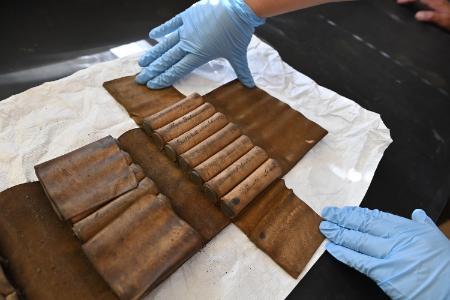Cadet Studies Civil War Medical Kit

Moriah Delozier ’28 holds one of the vials as she and Lt. Col. Kevin Braun discuss the spot test process in identifying the compounds. –VMI Photo by Kelly Nye.
LEXINGTON, Va. Oct. 30, 2025 — A cadet at Virginia Military Institute is revealing medical mysteries from the 19th century using 21st century technology.
Moriah Delozier ’28 majors in chemistry with double minors in history and literary studies. She also works as a cadet curatorial assistant at the VMI Museum. It was there she learned from museum registrar/curator, Cathy DeSilvey, that among the many intriguing artifacts found there is a leather roll-up field medical kit which belonged to Dr. J. A. Bennett, a physician servicing the Union Army in a field hospital during the Civil War.
The kit contains 19 sleeves, each holding a small cylindrical tin vial filled with a compound used for treating illnesses or injuries. Each sleeve is labeled in handwritten ink with the Latin name of the compound stored in the vial. For the safety of the museum staff and patrons, DeSilvey, along with Col. Keith Gibson ’77, executive director of the museum, requested the assistance of Lt. Col. Kevin Braun, associate professor in the Department of Chemistry, to safely dispose of the chemical residue in the vials. The request provides a unique opportunity for an independent study project for Delozier, under Braun’s supervision.
Delozier’s initial tasks were to translate the Latin names into English, learn what each compound consisted of, and ascertain its medical uses. To decipher the ancient words, she used a modern tool. “I Googled them to get the broad overview of what these Latin words mean. Most of them begin with the word ‘pulvis,’ which means powder in Latin, indicating they were in powder form. Others were originally in pill form.” After she translated the names, she went to Preston Library and found books on Civil War pharmaceuticals.
“I wanted to see what the Latin words meant from medical historians who had done their research. I also contacted the Society of Civil War Surgeons. They’re knowledgeable on Civil War medical procedures, and they were able to send me an exhaustive list of all the medicines and what conditions they treated.”
The next step was to confirm identification of the compound assumed to be in each vial. According to Delozier, an easy way to do that is chemical spot testing.
“We take a mixture of chemicals to test each compound within the different vials. We’re currently testing a tartar compound for the presence of antimony, and we were using a few different chemicals to see if it would form a precipitate. There can either be a color change that indicates the presence of antimony, or the formation of a solid. There also could be the possibility of when the vials are oxidizing, they’re also oxidizing on the inside, within the compound. This could be giving evidence of tin or lead.”
Braun added that each spot test includes a series of controls. “Those controls look for interfering agents and the presence of other species of interest. There is also a little bit of troubleshooting associated with each method.”
Braun and Delozier are also conducting instrumental testing on the compounds using instruments in the chemistry department.
“We’re going to try running some of the organic molecules using nuclear magnetic resonance spectroscopy, known as NMR, similar to an MRI in the medical field. The NMR is a smaller version that allows us to look at the connectivity of carbon-based molecules. The instrument will allow us to identify the carbon-based molecules and their degradation products. The hard thing is that medicine is compounded—multiple things are in it—so that’s where the spot testing is a nice first layer to figure out if it’s roughly what we think it is. Then we can separate the compounds and analyze them further,” explained Braun.
Delozier is thrilled to be able to combine her interests of chemistry and history.
“I think it's fascinating that this is American history, and being able to see it come to life so many years later, to test something that perhaps somebody was using over 160 years ago. I really love that realistic piece of history.”
The story behind the acquisition to the museum is almost as intriguing as the kit itself. A year ago, a woman who resides in Colorado, donated the item which belonged to her father, a retired lawyer and Civil War buff. Because of the small town nature of his practice, his clients often paid him in goods rather than cash. Through this method of payment, he received the kit from a grateful client.
Also included in the kit was a handwritten letter from Bennett to his wife and baby who waited for him to return home from the war. Among his eloquent and poignant words he wrote, “Oh God of battles, look with mercy upon our distracted country and restore to her, her wanted peace and prosperity. Towns, villages, and cities are laid waste, fields and farmhouses devastated, millions of money wasted, and almost every family north and south are mourning for loved ones lost.”
The full analysis of the kit will not be complete by the end of the semester. Delozier, who will be studying abroad during spring semester, hopes to continue her study of the compounds as a Summer Undergraduate Research Institute project in the summer. Once complete, the compounds will remain with the chemistry department and made available for others who may be interested in analyzing them. The medical kit itself will return to the VMI Museum for display.
Delozier is the daughter of Donavon and Loretta Delozier from Penhook, Virginia. Upon graduating in May 2028, she plans to commission into the Marine Corps.
Marianne Hause
Communications & Marketing
VIRGINIA MILITARY INSTITUTE
.svg)
.png)
